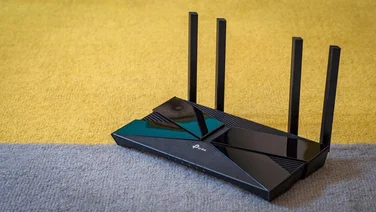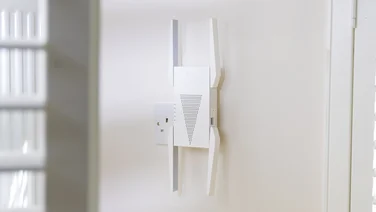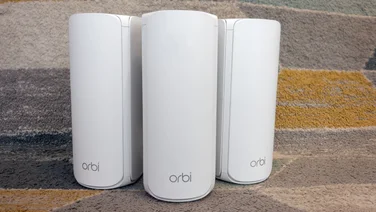To help us provide you with free impartial advice, we may earn a commission if you buy through links on our site. Learn more

Mesh Wi-Fi systems are an elegant solution to the problem of getting fast and reliable Wi-Fi access all over your home or business. While this technology has its downsides, it provides a solution to an internet-old problem: the need to receive an internet connection in every corner of your premises.
READ NEXT: Best mesh Wi-Fi router
Understanding standard Wi-Fi setups
The most common basic Wi-Fi setup consists of an internet gateway device, such as a fibre or cable modem, and a Wi-Fi router. In most cases, these devices are rolled into one, so you’ll have a single device that connects to the outside world and provides wired Ethernet and Wi-Fi connectivity for your local devices.Wi-Fi signals are strongest and fastest near the Wi-Fi router and get progressively worse the further you move away, or if walls or radio-blocking objects get between you and the device.
A single router is probably fine for a small home or flat, but if you live somewhere where there are dead spots in the places you need internet access, you’ll need a way to extend the Wi-Fi signal.
What is mesh Wi-Fi and how is it different?
Mesh Wi-Fi is essentially a distributed Wi-Fi router. The mesh system consists of multiple small Wi-Fi routers, or nodes, that appear as one large router to your Wi-Fi devices. The mesh nodes communicate with each other using a dedicated communications channel known as the “backhaul”.
Cheaper mesh systems use 5GHz Wi-Fi as shared backhaul, which does have performance implications, but usually not to the extent where it matters for the average household.
More expensive mesh systems will use an entirely separate band for backhaul that doesn’t share space with the 2.4GHz and 5GHz Wi-Fi frequency bands, eliminating those worries. In most cases, mesh nodes also have Ethernet ports, which can generally be used as the backhaul. So, for example, you may have two nodes connected via Ethernet between two floors of your home, with other nodes connected to them wirelessly.
Mesh Wi-Fi networks intelligently find the fastest and most reliable route from point A to point B. In most cases, this means finding the best route to the node that has internet access. However, when two devices on your local network need to speak to each other directly (for example, your Plex server and your smart TV), the data will be routed directly between them, giving you the best throughput possible.
READ NEXT: Best Wi-Fi extender
The advantages of mesh Wi-Fi
If you choose to upgrade from a standard router setup to mesh Wi-Fi, there are a few significant advantages.
Expanded Wi-Fi footprint: This is the most obvious and important advantage of mesh Wi-Fi. As long as the node you’re connected to has a good signal, you’ll enjoy the full benefits of your broadband connection anywhere in your home.
Simple roaming: As you move throughout the space covered by the mesh network, your devices will smoothly hand off between them, completely invisible to you. Other Wi-Fi expansion solutions often involve separate Wi-Fi network names, requiring manual switching.
Excellent performance: While this depends on the merits of the specific mesh network you’ve bought, mesh Wi-Fi generally provides consistent performance and latency throughout the network, as long as each node is in the sweet spot relative to other nodes.
Easy expansion: If your mesh network needs to be expanded to cover more space, it’s as easy as buying more nodes, which usually slot seamlessly into an existing mesh network.
READ NEXT: Best Wi-Fi 6 router
The disadvantages of mesh Wi-Fi
While mesh networks might seem like a no-brainer on paper, there are a few pitfalls to keep in mind.
Cost: Each node is a sophisticated device and essentially a Wi-Fi router itself, which logically makes a mesh system more expensive than less sophisticated methods of expanding a Wi-Fi footprint.
Setup can be tricky: Modern mesh systems aren’t hard to set up in terms of software and settings, but it can be tricky to get all of the nodes in the optimal spot, decide which should use wireless or wired backhaul, and figure out how many nodes you actually need. There’s often at least some experimentation involved until you get it just right for your space.
Compatibility: Some older Wi-Fi devices might not transition smoothly from one node to the next.
Not for power users: While it’s not true for every mesh system, those meant for home or small business use generally try to be as user-friendly as possible and don’t let you tweak as many aspects of your network as a traditional router. Similarly, you’re unlikely to find compatible custom third-party firmware for home mesh systems.
READ NEXT: Best business broadband
Mesh Wi-Fi alternatives
On balance, mesh systems are the best way to spread a Wi-Fi network over a larger space or through signal blockages, but they aren’t the only way to do it. There are cheaper alternatives that might be a better choice in some cases.
Wi-Fi repeaters: These devices simply receive and repeat your Wi-Fi signal. The main downside is that your Wi-Fi speeds are cut in half, but they’re cheap and, if you only need to extend your Wi-Fi moderately, a repeater can be a good solution. Read our Wi-Fi extender roundup for the best options.
Powerline Ethernet: These devices send network signals through the power lines of your home. If your house’s wiring is up to it, this can offer great speeds and reliable service. Usually, each end-point also has a Wi-Fi hotspot. It’s a good solution for extending your internet connection to a far-off bedroom or a guest house. Read our powerline adapter roundup for the best examples.
MoCA adapters: If you already have coaxial cabling for cable television in your home, you can use MoCA adapters to convert them to network cabling instead.
There are more exotic solutions, such as long-range Wi-Fi antennas, but these three alternatives are the most practical when a mesh system might be out of your budget range. Just bear in mind that you can expand your mesh network over time by adding more units.






